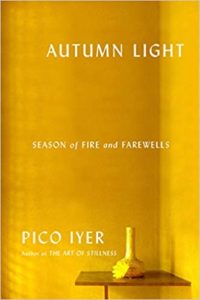Most Kyoto residents will be familiar with The Lady and the Monk, published in 1991, in which a foreigner in search of Zen finds unexpected love. Many may have finished the book wondering what happened to the couple. Reader, they married. Now, nearly thirty years later, we are presented with a follow-up. It’s not a sequel the author insists, but a counterpart – an autumn love story to balance the springtime mood of the earlier work. Think Linklater’s Sunrise Trilogy in lush prose.

The title is suggestive of the book’s theme, which has to do with aging and the relentless march of time. Indeed, autumn here is championed as Japan’s quintessential season. ‘Cherry blossoms, pretty and frothy as schoolgirls’ giggles, are the face the country likes to present to the world… but it’s the reddening of the maple leaves under a blaze of ceramic-blue skies that is the place’s secret heart.’ In traditional poetry the compelling beauty of autumn light is underpinned by awareness of the shortening days, suggestive of the Japanese aesthetics of sabi (forlornness) and the tradition of mono no aware (the pathos of beauty’s transience`).
Death, dying and dementia haunt the pages of the book, casting an autumn light on the proceedings as Iyer tells of family matters and aging table-tennis partners. An elderly mother in California, a mother-in-law in her dotage, a step-daughter involved with the wrong type of man. Then there’s the curious case of the estranged brother-in-law, whose Jungian studies go hand-in-hand with a refusal to engage with his family. It’s a surprisingly revealing book for an author who likes to treat Japan as a form of private retreat in contrast to his overseas assignments and public engagements. It means that he keeps a low profile while in Nara, where he focusses on his writing (unfortunately for WiK as we have been unable to book him as a speaker). Since most of the book is centred around his home in Nara, with occasional excursions to Kyoto, this second autobiographical work surely marks him out as Kansai’s prime creative foreign writer.
The first time I came across Pico Iyer was while reading a review of Remains of the Day (another autumnal work). The writer made the astonishing claim that the story offered excellent insight into the Japanese character, and such was my surprise I checked to see who the author was, wondering whether the name was some kind of joke. Since then I have followed his career with interest, and in the intervening years he has won a massive fan base around the globe (his Ted talks have been seen by over three million people). It’s worth speculating as to what underlies his appeal, apart from the self-evident honesty and sensitivity. The reflective asides can catch one unawares but they invariably stimulate thought, and there is much to be admired in the poetic, sometimes cryptic, style of language: ‘If autumn is a religion, it’s something you recite – or see with your eyes closed – more than put into words.’
Above all, Iyer is a keen observer, which may be why Japan suits him so well, for he is an outsider with no mastery of the language. In his observations he scratches away at the surface of life, probing for the essence of what it means to be human. ‘How to hold on to the things we love even though we know that we and they are dying. How to see the world as it is, yet find light within that truth.’ And here we see the subtle double meaning of the book’s title. Yes, autumn induces melancholy, but within that one must strive for positivity, just as in the face of aging the elderly folk in his table tennis club strive to improve their shots. Perhaps the Japanese with their stoicism have something to teach in this regard, for gambatte (do your best) is the national mantra and sacrificing self for the good of the whole leads to the well-being of the community. The ping-pong club provide an example.
There is not much action, but plenty of drama in the book. ‘Now I see it’s in the spaces where nothing is happening that one has to make a life,’ the author reflects. The sentence is suggestive of the Japanese aesthetic of ma (space), by which the emptiness within the bowl is what matters to the tea drinker just as the unpainted parts matters to the charcoal ink artist. How do we imbue everyday banality with significance, without letting life slip us by? Love and compassion are Iyer’s unspoken answers, and it is these qualities that he admires in spiritual teachers such as the Dalai Lama and the Tofuku-ji Zen master, even though their answers to life’s problems may seem commonplace. ’All this world is but a dream, be thou the joyful dreamer,’ sang The Incredible String Band in the 1960s, and there is something of that spirit in Iyer’s musings on his ‘autumn light’. Perhaps it represents acceptance on his part, and the book concludes with him sitting contentedly on his small balcony in Nara counting his blessings. A happy end, it seems…
‘But at my back I always hear
Time’s winged chariot hurrying near.’
